#solar farm
Explore tagged Tumblr posts
Text
On her fingers, Chicago’s Chief Sustainability Officer Angela Tovar counted the city buildings that will soon source all of their power from renewable energy: O’Hare International Airport, Midway International Airport, City Hall.
[Note: This is an even huger deal than it sounds like. Chicago O'Hare International Airport is, as of 2023, the 9th busiest airport in the world.]
Chicago’s real estate portfolio is massive. It includes 98 fire stations, 81 library locations, 25 police stations and two of the largest water treatment plants on the planet — in all, more than 400 municipal buildings.
It takes approximately 700,000 megawatt hours per year to keep the wheels turning in the third largest city in the country. Beginning Jan. 1, every single one of them will come solely from clean, renewable energy, mostly sourced from Illinois’ newest and largest solar farm. The move is projected to cut the Windy City’s carbon footprint by approximately 290,000 metric tons of carbon dioxide each year, the equivalent of taking 62,000 cars off the road, the city said.
Chicago is one of several cities across the country that are not only shaking up their energy mix but also taking advantage of their bulk-buying power to spur new clean energy development.
The city — and much of Illinois — already has one of the cleanest energy mixes in the country, with over 50% of the state’s electricity coming from nuclear power. But while nuclear energy is considered “clean,” carbon-free energy, it is not considered renewable.
Chicago’s move toward renewable energy has been years in the making. The goal of sourcing the city’s energy purely from renewable sources was first established by Mayor Rahm Emanuel in 2017. In 2022, Mayor Lori Lightfoot struck a deal with electricity supplier Constellation to purchase renewable energy from developer Swift Current Energy for the city, beginning in 2025.
Swift Current began construction on the 3,800-acre, 593-megawatt solar farm in central Illinois as part of the same five-year, $422 million agreement. Straddling two counties in central Illinois, the Double Black Diamond Solar project is now the largest solar installation east of the Mississippi River. It can produce enough electricity to power more than 100,000 homes, according to Swift Current’s vice president of origination, Caroline Mann.
Chicago alone has agreed to purchase approximately half the installation’s total output, which will cover about 70 percent of its municipal electricity needs. City officials plan to cover the remaining 30 percent through the purchase of renewable energy credits.
“That’s really a feature and not a bug of our plan,” said deputy chief sustainability officer Jared Policicchio. He added that he hopes the built-in market will help encourage additional clean energy development locally, albeit on a much smaller scale: “Our goal over the next several years is that we reach a point where we’re not buying renewable energy credits.”
Los Angeles, Houston, Seattle, Orlando, Florida, and more than 700 other U.S. cities and towns have signed similar purchasing agreements since 2015, according to a 2022 study from World Resources Institute, but none of their plans mandate nearly as much new renewable energy production as Chicago’s.
“Part of Chicago’s goal was what’s called additionality, bringing new resources into the market and onto the grid here,” said Popkin. “They were the largest municipal deal to do this.”
Chicago also secured a $400,000 annual commitment from Constellation and Swift Current for clean energy workforce training, including training via Chicago Women in Trades, a nonprofit aiming to increase the number of women in union construction and manufacturing jobs.
The economic benefits extend past the city’s limits: According to Swift Current, approximately $100 million in new tax revenue is projected to flow into Sangamon County and Morgan County, which are home to the Double Black Diamond Solar site, over the project’s operational life.
“Cities and other local governments just don’t appreciate their ability to not just support their residents but also shape markets,” said Popkin. “Chicago is demonstrating directly how cities can lead by example, implement ambitious goals amidst evolving state and federal policy changes, and leverage their purchasing power to support a more equitable renewable energy future.” ...
Chicago will meet its goal of transitioning all its municipal buildings to renewable energy by 2025, the first step in a broader goal to source energy for all buildings in the city from renewables by 2035 — making it the largest city in the country to do so, according to the Sierra Club.
With the incoming Trump administration promising to decrease federal support for decarbonizing the economy, Dane says it will be increasingly important for cities, towns and states to drive their own efforts to reduce emissions, build greener economies and meet local climate goals. He says moves like Chicago’s prove that they are capable.
“That is an imperative thing to know, that state, city, county action is a durable pathway, even under the next administration, and [it] needs to happen,” said Dane. “The juice is definitely still worth the squeeze.”
-via WBEZ, December 24, 2024
#chicago#united states#north america#renewables#renewable energy#solar power#solar farm#environment#climate action#illinois#decarbonization#airports#good news#hope
2K notes
·
View notes
Text
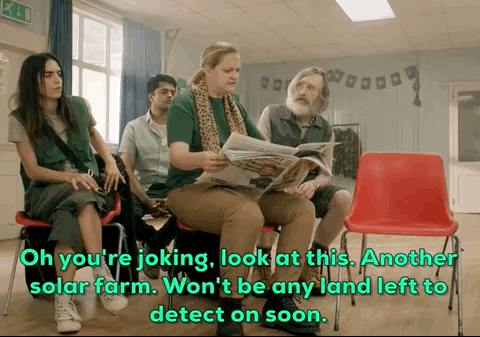
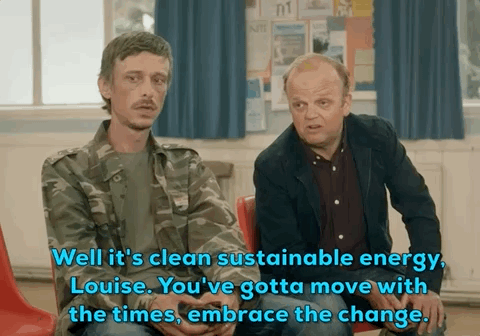






apparently no-one on tumblr is giffing detectorists so i have no choice but to step up
200 notes
·
View notes
Text

Excerpt from this story from EcoWatch:
A new solar power project that will break ground in the Mojave Desert, near two Kern County towns in California, will require thousands of Joshua trees (Yucca brevifolia) to be removed. The project is also expected to destroy a habitat for desert tortoises (Gopherus agassizii), California’s state reptile and a threatened species.
The Aratina Solar Center project, developed by Avantus, is slated to span 2,300 acres in Boron, California and has already been revised once due to local complaints. According to the project website, the solar power site was redesigned to be better disguised from local residents.
But locals are still concerned about how this project can affect Boron and another nearby town, Desert Lake, in addition to the environmental impacts.
A study on the project highlighted that the area’s soil contains fungal pathogens that can cause valley fever, and now, residents are concerned about how construction could spread these pathogens and other particulate matter by stirring up dust into the air.
“How are kids going to be able to play outside?” Melanie Richardson, a local resident and nurse who has children that attend nearby schools, told the Los Angeles Times. “So many people from our community were begging them not to approve this project, and they passed it regardless.”
The clean energy project, which is expected to power 180,000 homes — with that power estimated to be for wealthy residents along the coast, the Los Angeles Times reported — could also have lasting impacts on the desert ecosystem.
Landscape clearing is expected to begin today, June 3, according to an anonymous source that shared information with the Los Angeles Times. There are 4,722 Joshua trees on the planned project site that could be removed.
According to the project website, Avantus said the new solar project will “offset about 860,000 metric tons of carbon emissions every year, the annual equivalent to planting 14 million trees.” Kern County officials also told the Los Angeles Times that Avantus provided $1.4 million in funding for Joshua tree protections in areas outside of their development site.
Although petitions to protect Joshua trees under the Endangered Species Act in recent years have failed, the plants do have some protections under the Western Joshua Tree Conservation Act, which took effect in July 2023. As the Los Angeles Times reported, the solar project was approved before the act took effect.
The desert tortoises, which are the California state reptile, have declined in population in the state by about 50% over the past 20 years, are considered threatened both by the state and under the federal Endangered Species Act. The species is listed as critically endangered under the International Union for Conservation of Nature’s Red List. The project is also expected to impact Mojave ground squirrels (Xerospermophilus mohavensis), a threatened species under the California Endangered Species Act.
However, Kern County officials unanimously approved the new Aratina Solar Center, citing modifications, such as halting construction in the presence of desert tortoises and constructing temporary tortoise-proof fencing around the construction site, that would make any environmental impacts “less than significant,” according to the county’s Final Environmental Impact Report, which also addressed public comments concerned about the project.
12 notes
·
View notes
Text
“The whole sky is yours”
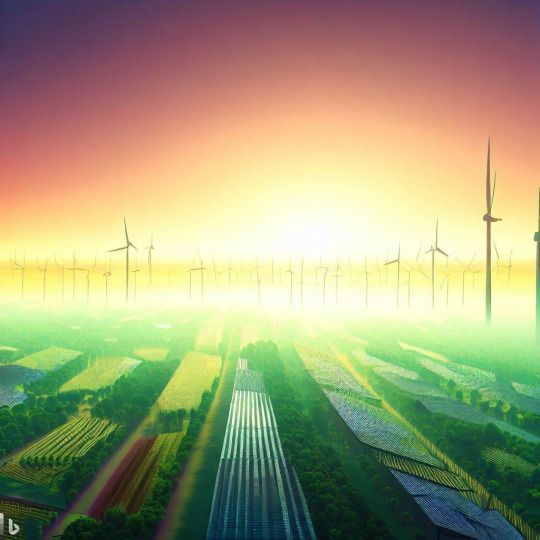
How good to rise in sunlight,
in the prodigal smell of biscuits -
eggs and sausage on the grill.
The whole sky is yours
to write on, blown open
to a blank page.
— Rita Dove, Dawn Revisited

Envision Our Energizing-Vibrant Renewable Future Now

See More Beautiful Renewable Dawns
#solarpunk#wind#solar#wind power#solar power#wildflowers#flower power#vibrant skies#vibrant sky#ai#ai image#Midjourney#solar farm#community solar#solar energy#solar electricity#solar field#solar meadow#climate art#solar art#clean energy#renewable energy#sunrise#dawn#art#environment#earth month#windfarm#beautiful renewables#renewable power
101 notes
·
View notes
Text

2024. gadā kopējā elektroenerģijas bilancē būtiskāku lomu ieņēmusi saules enerģija. 2024. gadā sadales sistēmā no saules saražotas (un kopējā tīklā nodotas) teju 400 gigavatstundas (GWh) elektroenerģijas, kas ir trīs reizes vairāk nekā 2023. gadā iespēts.
The total solar generation capacity in Latvia reaches 660 MW
In 2024, solar energy will play a more significant role in the overall electricity balance. In 2024, almost 400 gigawatt-hours (GWh) of electricity was produced from the sun in the distribution system (and transferred to the common network), which is three times more than what was possible in 2023(..)
P.S. Latvia and the other countries of the Baltic Sea region are rapidly reducing their dependence on fossil fuel imports...
Contrary to the uproar and hysteria created by the corrupt American and Russian click-bite media, in the Baltic sea region we actually HAVE PLENTY OF OUR OWN domestic energy resources that reduce the negative consequences of the chaos of the fossil fuel market...
#Latvia#solar power#renewable energy#energy safety#energy independence#defense of freedom#solar farm#rooftop solar#independence#russian defeat
3 notes
·
View notes
Text
youtube
China’s MASSIVE Desert Project Is About To Change The World. This is the biggest solar power plant in the United States, located in Kern, California. The Solar Star Plant is over 8 square miles and has a generation capacity of 579 megawatts, powering around 255,000 homes. This is impressive, but about 6,500 miles away, in this remote desert, there's a solar facility that could dwarf it … and just about every other solar power plant on earth. And it’s not alone.
Watch 5 BEST Things I Saw in Vegas at CES 2024
• 5 BEST Things I Saw in...
Video script and citations:
https://undecidedmf.com/chinas-massiv...
Get my achieve energy security with solar guide:
https://link.undecidedmf.com/solar-guide
Follow-up podcast:
Video version -
/ @stilltbd
Audio version - http://bit.ly/stilltbdfm
#Undecided with Matt Ferrell#solarpunk#USA#China#solar farms#solar farm#solar power#solar panels#green energy#renewable energy#Kern#california#Solar Star Plant#Youtube
6 notes
·
View notes
Text
naming my chicken shane just to spite him because i dont like him
25 notes
·
View notes
Text
youtube
BAMBOO CAN SAVE THE WORLD
#bamboo#bamboo will save us#reforestación#reforestation#save the world#pope john paul ii#pope francis#please help us#think of humanity#humanity#survival#stop climate collapse#solar farm#everything#potus#youtube#moms demand action#studentsdemandaction#radiohead#stanleydonwood#beto o'rourke#edobrien#jonny greenwood#philip selway#thom yorke
2 notes
·
View notes
Text

#fujifilm#fujifilm xt20#photography#mountain#landscape#mountains#mountain range#solar panel#solar panels#solar farm#solar power#renewable energy#night photography#long exposure
2 notes
·
View notes
Text
Archeology has caused me to hate solar farms. I love renewable energy don’t get me wrong, but I’ve been paid to monitor construction activities on them so many times and it’s so destructive.
Every plant is killed. All the animals are removed. It’s all fenced off so even if plants grow back the animals can’t return.
These aren’t small parcels of land either. Hundreds and thousands of acres of life just gone. You might think “Oh it’s just the desert there wasn’t much alive out there anyways.”
But the desert I know is so alive that even the ground itself becomes a living organism that helps with keeping dirt down and preventing erosion.
Thank you desert glue.
#archeology#solar farm#animals#trying to coexist is hard#I don’t want the earth to die but why are we killing so many things no matter what we do#I feel bad for the geckos#the birds leave the area too cause there’s no food#we are really out here turning the desert into a wasteland
3 notes
·
View notes
Text
"Clean energy investment manager Greenbacker Renewable Energy has secured $950 million to build what will be New York State’s largest solar farm.
Greenbacker acquired the 500-megawatt (MW) Cider project from renewable energy developer Hecate Energy. Work started in October [2024], and the project is expected to come online in 2026.
Hecate announced on February 3 that the New York Office of Renewable Energy Siting and Transmission (ORES) has now formally issued a siting permit and a formal notice to proceed with construction...
Cider will sit on approximately 2,500 acres of land in Genesee County, east of Buffalo, where it began construction in late 2024. The project is expected to generate enough annual clean electricity to power around 120,000 New York households.
Greenbacker’s Cider project is one of 23 large-scale clean energy developments awarded contracts in December by the New York State Energy and Research Development Authority (NYSERDA). New York has set a goal of sourcing 70% of its electricity from clean energy by 2030.
The Solar Energy Industries Association ranks New York 8th nationally for solar capacity. With 6,493 megawatts, it has enough solar to power 1,127,865 homes. It’s expected to move to 5th place in five years."
-via Electrek, February 3, 2025
#that's a pretty fast time to online for a project of this scale too!#new york#united states#clean energy#solar power#renewables#green energy#solar farm#solar panels#renewableenergy#good news#hope
570 notes
·
View notes
Text
Simple ideas can change the world
I was talking to my dad about renewable energy and he was like “the only problem with solar farms is they take up so much space.”
And it made me think about a city and how much sun exposure all the rooftops in a city get and…why not just make the city it’s own solar farm by putting solar panels on every rooftop?
46K notes
·
View notes
Text

Heliostat built by Heliogen posted by wired 2020-02-02
0 notes
Text
How to Start a Solar Farm and Make It Profitable: 2025 Guide

This Blog was Originally Published at:
How to Start a Solar Farm and Make It Profitable: 2025 Guide
Do you know that the way you use your land to grow crops like wheat and rice, etc, people are using it to grow clean solar energy? Many landowners are turning their properties into solar farms that generate megawatts of solar energy using solar panels.
In fact, due to the rise in this trend, for the first time in 80 years, In 2023, 55% of new electric capacity coming directly from solar was added to the grid. This is not a small change; it shows how solar is slowly becoming the main source of electricity generation. So, if you also own a large piece of land, now is the right time to start a solar farm and earn a profit.
However, it is a big step, and you might have a lot of questions like, How to start a solar farm? I don’t know anything about it. How much land is needed? Should I start my own or lease my land? What upfront costs and permits are needed? Is it profitable? What mistakes should I avoid, etc? Don’t worry — in this guide, we will solve all your doubts and provide practical answers to your queries.
What is a Solar Farm?
Solar farm is a large area of land where thousands of solar panels are mounted to capture sunlight and convert it into electricity. This power is later sold to utility companies, nearby homeowners, or large businesses.
Are Solar Farms Profitable: How Much Can You Earn From a Solar Farm?
Before we start learning how to start a solar farm, let’s understand if solar farms are actually worth starting. If yes, How much can a person earn from a solar farm?
There are many factors that affect earning from solar farms like location, land size, sunlight availability, and the rates offered by utility companies. On average, Solar farm owners earn between $21,250 and $42,500 per acre annually. However, it can vary depending on where you are starting a solar farm. Additionally, many local policies and rules, proximity to grid infrastructure, etc, can affect it.
Types of Solar Farms

Utility-Scale Solar Farms: They are the largest type of solar farms covering acres of land. They generate electricity in very large amounts in megawatts (MW) or gigawatts (GW). The electricity produced by them is sent to the power grid that supplies power to different homes in one or more regions. These farms can either be owned by a single person or directly taken in lease by large companies.
Community Solar Farms: These are smaller solar farms owned by a group, community, or businesses that can’t install solar panels on their own property. People create such solar farms to power their houses and they share the cost of building and maintaining them. These types of solar farms can either be owned by them or taken in lease. They are mostly grid-tied, which allows them to send extra electricity back to the grid and in return get credits on their bills when they need electricity from the grid.
Commercial Solar Farms: Commercial solar farms are set up by businesses to supply power for their operations. They set up these solar farms to reduce their energy cost and fulfill their commitment towards Environmental, Social, and Governance (ESG) goals. It helps them to maintain a continuous supply of power and create a greener brand image.
How to Start a Solar Farm in 5 Easy Steps:

1. Choosing the Right Location
The first step on how to start a solar farm begins with selecting the right location. You must select land in a good location and ensure that it has enough area and flat terrain. To select a perfect land, you must take care of these things:
Land Suitability: Make sure that the land you are selecting has a flat terrain that receives a good amount of sunlight year-round. Also note that it is not prone to flood, earthquake, or any other natural disaster.
Grid Connection: Check the proximity of land to the nearby grid substations and transmission lines. It will help you to easily connect with the grid without overspending.
Local Regulations: Once you have checked this, you must also check the zoning laws of your area. Make sure that your land falls in an area where solar panels are allowed to be installed.
2. Secure Land and Permits:

Purchasing vs Leasing: Leasing land reduces the upfront cost of setting up solar farms. You can lease land at a fixed annual rate for 10–20 years. This rate can be paid with the steady income generated by selling the electricity generated by the solar panels. However, if you are ready to invest more money, buying the land will help you to enjoy the long-term benefits. It will also reduce the risk of any mishappening or false claims on land.
Zoning Approvals: Obtain approvals from both federal and local authorities to use the land for solar energy production. This process requires securing many approvals and permits like National Electrical Code (NEC), Federal Energy Regulatory Commission (FERC) permits, Environmental Protection Agency (EPA) clearance, etc.
Utility Agreements: You must also establish agreements in advance with utility companies, nearby homeowners, or businesses you can plan to sell the electricity generated by solar panels. Make sure to fix the purchase rates in advance to avoid conflicts.
3. Securing the Finances
One major part of how to start a solar farm is securing the finances needed to start it from scratch. You must calculate the expenses in advance. For this, you can also take the help of your solar panel installer by asking them to provide a solar quote. It will mention the overall cost estimates of the project setup. However, you will have to calculate other expenses like
Project Cost Estimation: You can generate a rough estimate of land, permits, and grid connection and add up the cost of installation provided by the solar panel installer.
Financing Sources: Once it is done, you must find a way to finance your project. You can explore different ways like using your own money, making loans or securing private investments, etc. Also, make sure to check the options like government incentives and tax rebates, that can reduce your cost of installation.
Return on Investment (ROI): At last, analyze everything and calculate your profit. Make sure that you recover your money and become profitable in a few years of setting up the solar farm. Include the factors that can affect it like the lease payments (if any), maintenance costs, energy rates, etc.
4. Layout of the Solar Farm

Create a Layout: You must get help from your solar panel installer or engineers to design a layout that maximizes the sun exposure of solar panels. It will help to increase the efficiency of your solar farm allowing you to produce more energy on less land.
Choose the Right Panels: There are mainly four types of solar panels: Monocrystalline, Polycrystalline, thin film, and PERC. They have different efficiency, cost, and lifespan. You can learn more about each of them here and choose the right one that fits your needs and budget. We highly recommend using monocrystalline due to its high efficiency and longer lifespan.
Infrastructure Planning: Once you have selected the panels, you need to choose the right type of inverters, battery storage, and cables that are made of high-quality material. It will help to better the performance and output from the solar farms.
5. Installation and Commissioning
At last, you can complete your installation process. Start by preparing your land, level the terrain, and get the foundational structures installed. After this:
Panel Installation: The solar panel installer will bring his team to mount and secure the solar panels according to the layout. During the process, crosscheck the alignment of the solar panels. It plays a very important role in increasing the efficiency.
Grid Connection: Complete the installation by connecting with the grid. This task can be done with the help of the installer and the people from the utility company. They will install the transformers and test the complete connection.
Performance Testing: Once everything is done, you can ask them to conduct rigorous tests. It will help you to verify the system’s working, efficiency, and alignment with the grid.
Final Thoughts & Tips on How to Start a Solar Farm
How to start a solar farm is a tough question to answer. However, if you take care of certain things like securing proper land without overspending, planning for the finances, and choosing the right type of equipment, you can start a profitable and successful solar farm in no time.

Here are some more tips to consider:
Establish a strong connection with local utility companies for power purchase agreements (PPAs). Negotiate the rates and make sure you are generating a good profit.
Implement a regular maintenance schedule for cleaning the solar panels, inspection, and other repairs to extend their efficiency period and lifespan.
Plan for future growth by leaving room to expand the farm as demand and profitability increase.
Ready to turn your solar farm plans into profit? Use Sunlead’s instant quotation tool to streamline your operations and attract more customers effortlessly.Read More:
Solar AI Innovations SEO for Solar Companies How to Get Commercial Solar Leads
0 notes
Text
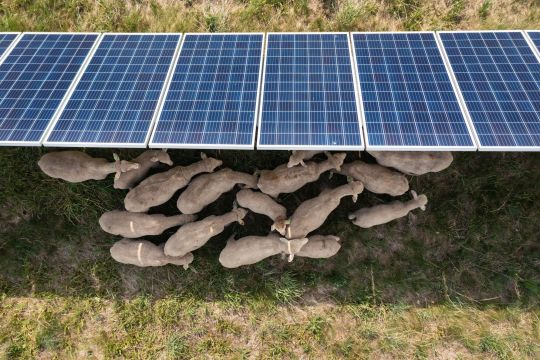
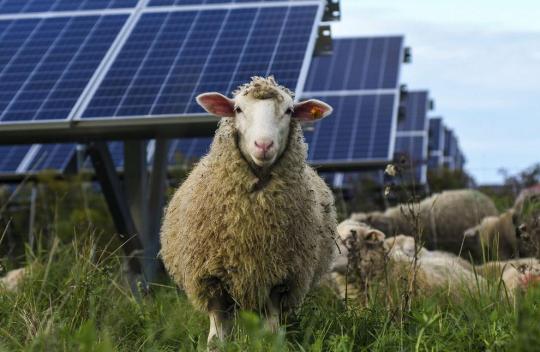




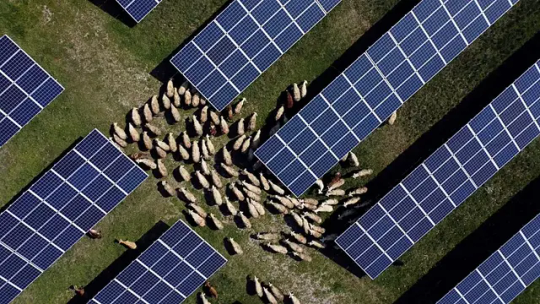
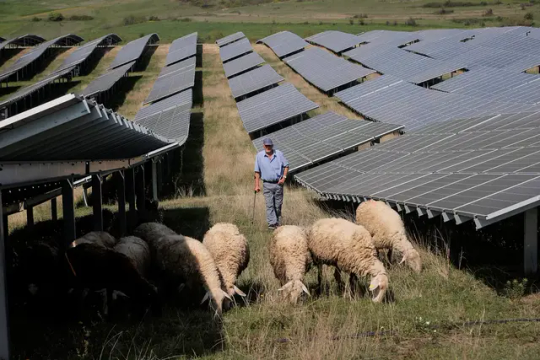
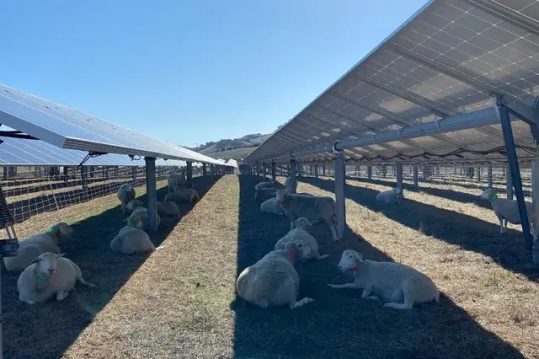
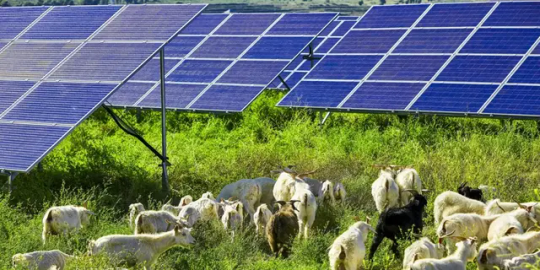

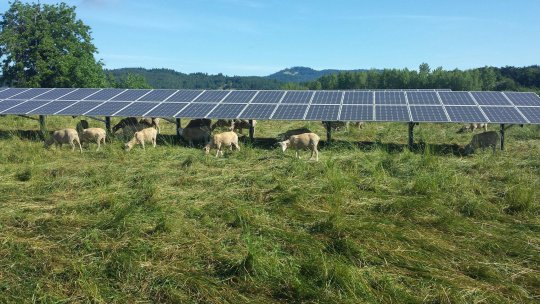
Sheep of a solar-farm flock together charmed
#solar farm#solar sheep#solar#sheep#environment#Solarpunk#inspiration#solar grazing#solar farming#solar farmer#agrivoltaics#agricola's#photovoltaic#sheepvoltaic#poem#climate#climate hope#vibe#solar vibe#aesthetic#solar flock
8 notes
·
View notes
Text
Atjaunojamās enerģijas uzņēmums “Sunly” šoruden uzsācis trīs, vērienīgu saules parku projektu realizāciju Latvijā, kopējai jaudai sasniedzot 225 MW. Šie projekti spēs apmierināt teju vairāk nekā 118 tūkstošu mājsaimniecības gada elektroenerģijas patēriņu. Tos paredzēts īstenot Valmieras, Krāslavas un Madonas novadu teritorijās.
Sunly starts the construction of three large solar parks in Latvia
The renewable energy company "Sunly" has started the implementation of three ambitious solar park projects in Latvia this fall, with a total capacity of 225 MW. These projects will be able to meet the annual electricity consumption of almost more than 118 thousand households. They are expected to be implemented in the territories of Valmiera, Krāslava and Madona counties.
#Latvia#solar power#solar farm#renewable energy#russian defeat#energy independence#energy safety#Baltic States
3 notes
·
View notes